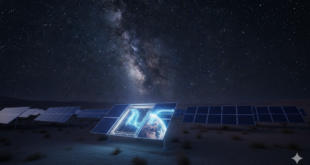Introduction:
In our quest for lunar exploration and potential colonization, securing a reliable and efficient power supply is paramount. Cutting-edge technologies in power distribution and transmission are at the forefront of lunar missions, serving as the lifeblood of future lunar bases and settlements. In this article, we delve into the latest breakthroughs in wireless power transmission, superconductivity, and nanotechnology, all of which are poised to revolutionize lunar power infrastructure.
- Solar Power Revolution: Solar power is a game-changer for lunar missions. The Moon’s surface receives abundant sunlight, but its day-night cycle lasts about 14 Earth days. To harness this energy, flexible and lightweight solar panels designed to withstand extreme temperature variations have been developed. These advanced photovoltaic systems are critical for providing continuous power to habitats, rovers, and scientific instruments.
- Regenerative Fuel Cells: Regenerative fuel cells, such as hydrogen-oxygen fuel cells, are becoming an integral part of lunar power systems. These cells not only produce electricity but also generate vital resources like water. By splitting water into hydrogen and oxygen during the lunar day using surplus energy from solar panels, regenerative fuel cells store energy for use during the long lunar night, ensuring uninterrupted power supply.
- Advanced Batteries: Innovative battery technologies are essential for storing excess energy for lunar nights and providing backup power during critical operations. Lithium-ion and solid-state batteries with improved energy density, durability, and thermal stability are emerging as dependable energy storage solutions for lunar missions.
- Nuclear Power: Nuclear power systems, including radioisotope thermoelectric generators (RTGs) and small fission reactors, offer a continuous and efficient energy source for lunar colonies. RTGs have been used in previous space missions and can provide long-term, low-maintenance power. Compact fission reactors, currently in development, may supply even more substantial energy for lunar habitats and industrial operations.
- Power Distribution Grids: Efficient power distribution is vital for managing and delivering electricity to various lunar facilities. Smart grids and power management systems help optimize energy use, prioritize essential tasks, and minimize waste. These systems rely on sensors, data analytics, and automation to ensure seamless energy flow.
- Lunar In-Situ Resource Utilization (ISRU): To reduce reliance on Earth for resources, lunar missions are exploring In-Situ Resource Utilization. For power generation, this involves extracting lunar resources like helium-3 or using the Moon’s regolith as shielding material for nuclear reactors, minimizing the need for costly imports from Earth.
Wireless Power Transmission
- NASA’s Artemis Mission: NASA is spearheading the development of a wireless power transmission system for its Artemis mission to the Moon. The system employs microwaves to transmit electricity from solar panels on the lunar surface to a receiver on the Lunar Gateway, a space station orbiting the Moon. This groundbreaking technology eliminates the need for physical connectors, enhancing lunar power distribution flexibility.
- Emrod’s Long-Range Transmission: Emrod, a pioneering company, is working on a wireless power transmission system with a remarkable capability to transmit electricity across distances of up to 10 kilometers. While still in early stages, this system holds immense potential for distributing power from large-scale lunar solar and wind power plants to lunar bases and settlements, reducing energy losses during transmission.
Superconductivity
- SpaceX’s Starship Innovation: SuperPower, a forward-looking company, is developing a superconducting power cable system for SpaceX’s Starship spacecraft. This system will efficiently transmit electricity from Starship’s solar panels to its engines, optimizing power distribution within the spacecraft.
- Artemis Mission Advancements: American Superconductor is making significant strides in the development of a superconducting power cable system for NASA’s Artemis mission. This technology will facilitate the transmission of electricity from a nuclear reactor located on the lunar surface to lunar bases, ensuring a reliable and sustainable energy source.
Nanotechnology
- Lightweight Solar Panels: NanoAvionics is at the forefront of nanotechnology-based solar panel development. Their lightweight and durable solar panels offer a promising solution for generating electricity in lunar environments. These panels have the potential to power lunar bases and settlements efficiently.
- Advanced Thermal Insulation: Aerogel Technologies is pioneering a nanotechnology-based material known for its exceptional lightweight properties and outstanding thermal insulation capabilities. This material has the potential to enhance the durability and efficiency of power lines and other lunar infrastructure components.
The Future of Lunar Power:
Innovative power distribution and transmission technologies are essential for the success of moon exploration and colonization efforts. By harnessing the Sun’s energy, developing advanced energy storage solutions, and incorporating nuclear and ISRU technologies, we are paving the way for a sustainable lunar future. These innovations not only support human presence on the Moon but also serve as valuable stepping stones for future missions to Mars and beyond.
Researchers are continually pushing the boundaries, developing wireless power transmission systems capable of longer-distance and more efficient electricity transfer. Additionally, they are increasing the operating temperatures of superconducting materials, making them more practical for lunar applications.
In conclusion, these innovations in wireless power transmission, superconductivity, and nanotechnology are set to revolutionize lunar power infrastructure. As we harness these cutting-edge technologies, we are not only ensuring a sustainable lunar presence but also paving the way for future deep space exploration and colonization. The lunar surface is poised to become a testbed for pioneering energy solutions, driving our exploration of the cosmos to new heights.
 International Defense Security & Technology Your trusted Source for News, Research and Analysis
International Defense Security & Technology Your trusted Source for News, Research and Analysis




